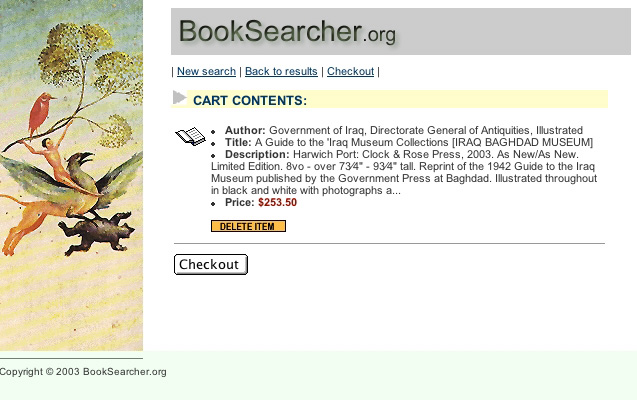LIFEBOAT: Staying Afloat in the Rising Floodwaters of Internet Book Sales
- by Renee Roberts

Same listing this time via a "free” search engine, now at $253.50
Unlike new books, which can be uploaded from a publisher-generated, industry-standard database, used books must be examined and entered one at a time. Moreover, the pricing which might have held within the confines of a store has to be re-examined in the context of the marketplace in which the book is sold, and then adjusted based on competitive offerings.
That said, my data entry skills are as fast as those of anyone else I know, and it still takes me a long time to do data entry for a single antique book. I can’t tell you how many nights and weekends I have stayed up late, typing entries into my store’s database in order to get enough titles online to reach critical mass in Internet sales.
Consider the situation of booksellers who own tens of thousands of titles, and are faced with this daunting task for the first time. Like many mature business owners, they may not know how to type at all, let alone how to use a computer efficiently. There are technological barriers as well: How do you use a database? What kind of Internet connection is necessary? Who is going to take digital pictures and how do you process and edit them? Where on the Internet do you even sell your books?
What about personnel? Who is going to do all this data entry, and who do you trust to do it? I’ve trained a couple of people, who shortly thereafter have gone out and started their own Internet book businesses — not a very satisfying activity.
In the end, after reaching “critical mass” in our store, we just settled on my own abilities to do data entry and developed a more relaxed attitude about the thousands of books sitting around in boxes waiting for their chance to shine online. But it remains a problem — whereas in a physical shop books of a genre can be shelved together and easily found by customers, on the Internet you cannot sell what you haven’t listed.
Many traditional sellers have responded to this problem by giving up the ghost and selling their inventory at huge discounts to the hordes of book predators that hang around at book sales, rather than trying to climb the steep computer-and-data-entry learning curve and commit to doing this very detailed and time-consuming work on their own. And in their absence a new generation of computer-literate dealers has proliferated, whose skills lie more in the realm of computer programming than in higher education.
These programmer-sellers have come up with solutions to the bookseller inventory problem that are large on creativity, but fall a bit short on ethics, let alone customer service and respect for the trade. Let me give you some examples…
There are dealers’ listings on all of the major bookselling trading sites that appear to be identical. They will say things like “in used or better condition, may have remainder mark” as though they are not sure what their book even looks like. These sellers are not just saving time by repeating the same description — they don’t know what their book looks like because they don’t own it. Instead they have posted hollow computer-generated listings based on ISBN numbers and have populated the description fields with stock comments, such as the all-inclusive “Very Good Condition”.